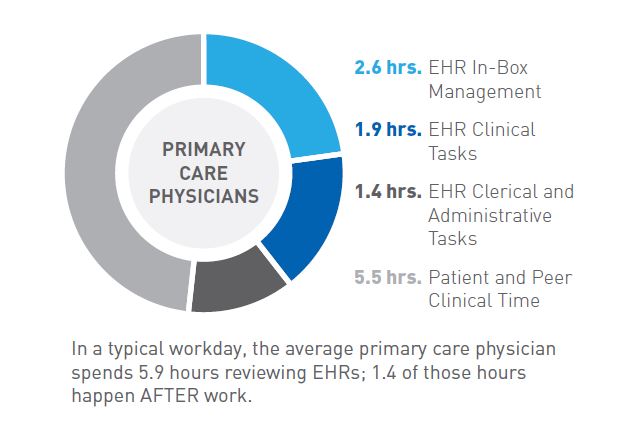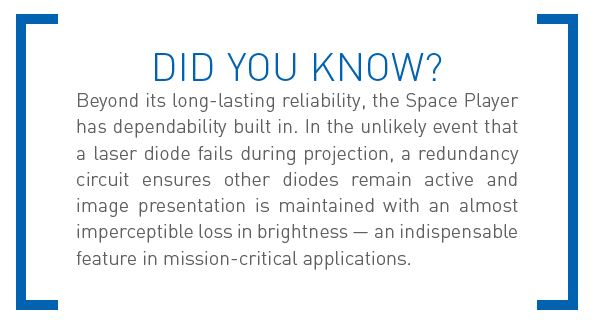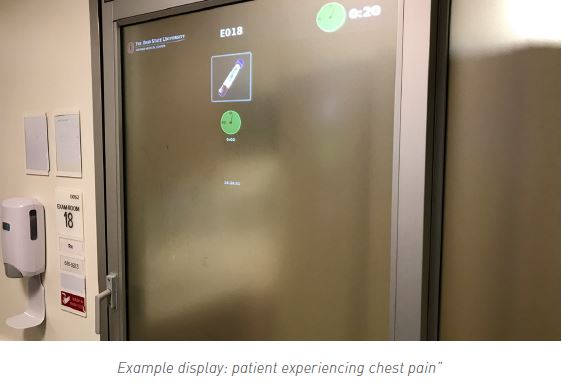December 19, 2018
7 min read
CASE STUDY: THE JAMES - OSUCCC
Panasonic Space Player helps transform emergency room care at The James
THE OHIO STATE UNIVERSITY COMPREHENSIVE CANCER CENTER
Challenge
How do you use patient data to improve emergency room care without forcing doctors and nurses to spend even more time on a computer — time that could be spent caring for patients?
Solution
Turn ER doors into display panels for patient charts, vital signs, and task alerts.
Result
The James – The Ohio State University Comprehensive Cancer Center (OSUCCC – James) used a Panasonic PT-JW130 Space Player to project groundbreaking patient information displays that have liberated caregivers.
Saving lives with data visualization
As chief innovation officer (CIO) at The Ohio State University College of Nursing and previously the Emergency Department quality manager at OSUCCC – James, Tim Raderstorf has a lifesaving goal: use information technology to identify and present critical information to doctors and nurses so they can stop relying on the current patchwork system of checklists and their own memories.
A 2016 study by researchers at Johns Hopkins found that medical errors kill 250,000 Americans nationwide a year, making medical mistakes the number three cause of death in the country. Only cancer and heart disease cause more fatalities.1
With stakes that high, even small gains can save hundreds of lives. Given the mass migration to electronic health records (EHRs) and evidence-based medicine, it seems like the information doctors need should be at their fingertips. But according to Raderstorf, all that data isn’t creating the results everyone hoped.
Data, data everywhere…
“Electronic health records have not been the godsend we hoped for,” says Raderstorf. “It’s been a major disruption, and clinical staff are taking the brunt of it.”
The data confirms it. Researchers from the University of Wisconsin and the American Medical Association found that primary care physicians spend more than one-half of their workday interacting with the EHRs during and after clinic hours, and cited the inefficiency and distraction of communicating with team members through an EHR as a cause of physician burnout and increased workload.2 Other studies found that primary care physicians actually spent more time working with EHRs than they spent face-to-face with patients in clinic visits.3 Nurses face a similar predicament: studies show that nurses spend more time with EHRs than in in-person communications with healthcare workers about patients or on patient care.4
A registered nurse (RN) as well as a CIO, Raderstorf knows both sides of the situation. “Spending half a day, every day, on data input messaging pulls doctors and nurses away from patients. The system that was supposed to inform and improve care is doing the exact opposite.”
The problem isn’t the idea of electronic records. Accurate data is crucial to making better decisions. But current EHRs make data collection and management the primary goal. Insight comes days, weeks, or even months after a patient receives care, which is far too late to prevent a mistake or save a life.
To have a real impact, health data needs to serve doctors, nurses, and patients at the moment when it can help them make the best possible decisions.
An idea hatched in a job interview
Jason Walsh, RN, MBA, served as the director of Emergency Services at the hospital for over five years. Back in 2012, Walsh was looking to hire a new quality manager, and Raderstorf interviewed for the position. During the first interview for the job, Walsh threw him a challenge.
“We were in the middle of renovating the ER, but there was no budget for doors on the patient rooms,” says Walsh. “As nurses, Tim and I both knew when you don’t have doors, patients don’t have privacy and noise goes way up.”
“I told Jason to give me a week to think about ways to justify the added expense of doors,” recalls Raderstorf. “I thought, ‘What if we could use the door as a display panel for patient charts and performance indicators?’”
The hospital signed off on the idea, and soon the two were prototyping the system. They experimented with several approaches before homing in on the most valuable toolset for doctors.
“We decided to create an interactive visual interface that could use numbers, badges, and colors to translate critical data into the kind of immediate information you need in an ER,” says Walsh.
There was only one problem: how to display all that information. The team struggled to find the right hardware for the job for several design cycles. They tried tablets, but their small size and single-direction displays left patients out of the loop. Projectors could fill an entire door with information, but most projector technology couldn’t meet the rigorous requirements of an ER installation.
“There are epidemiology and infection-control concerns,” says Walsh. “We can’t have a projector dumping heat into the room or a fan that collects dust and airborne pathogens.”
The team also didn’t want to be on a ladder every few months replacing bulbs. They needed a projector that could run 24/7 and produce a high-resolution image. A sealed digital laser projector (DLP) seemed like a perfect fit, except standard DLPs literally couldn’t fit in the ER.
“The things were the size of a suitcase,” says Raderstorf. “We just don’t have space to mount a huge projector in every room.”
The team was stumped until they discovered the Panasonic Space Player.
The Space Player comes into play
Designed to look and mount like a standard track-lighting fixture, the Space Player is a unique hybrid that combines the functions of a customizable spotlight with a video projector in a sleek, compact body.
Panasonic’s SOLID SHINE laser technology tackled all of Walsh and Raderstorf’s requirements.
Thanks to the long-lasting dual solid-state laser modules, there are no lamps to replace, and image color and brightness degrade very gradually in a linear fashion. This simultaneously ensures that consistent picture quality is preserved longer and reduces maintenance for filter cleaning and bulb replacement. In fact, the filter-free design delivers approximately 20,000 hours of maintenance-free, continuous 24/7 operation.7
“For sterilization purposes, we routed power and Ethernet cords immediately above and into the ceiling,” says Raderstorf. “Fluids don’t saturate the projector’s case, so airborne liquids can’t penetrate the projector, and it is easy to clean.” Additionally, the Space Player is designed with a dust-resistant laser drive and airtight optical engine so that the unit collects very little dust, making it ideal for the sanitized environment of a hospital.
From concept to reality
For their beta version, the team developed proprietary software to extract data from the hospital’s EHR system. They created their own visual language to turn the raw EHR data into badges, color-coding, and text that deliver the crucial information caregivers and patients need at a moment’s notice, including protocols and elapsed time.
“It is a highly symbolic language that protects patient privacy but communicates urgent information,” explains Walsh. “If a patient is admitted with chest pain, their door will display their live EKG and a badge signifying chest pain with a countdown clock that starts the moment the patient enters the room.”
With chest pain, the display counts down the 10 minutes the ER team has to meet key steps in the hospital’s care protocol. Different care scenarios trigger different protocols. For example, the display will count down from 37 minutes for a head injury — the deadline for a CT scan. For patients with less urgent issues, the clock can help caregivers track time between visits and vitals checks.
Because the doors are glass, the display is clearly visible from outside and inside the room. The team methodically designed the experience so that it communicates with patients — and their families — just as effectively as it communicates with doctors and nurses.
For example, when a test result is in or imaging comes back from radiology, an alert post on the door for everyone to see. By sharing information with patients, the solution aims to foster a better patient experience.
Final thoughts and next steps
“We’ve been incredibly happy with the solution,” stated Raderstorf. “Because of its sleek design, the hardware goes unnoticed in this application. That’s key — we aren’t trying to replace one cumbersome technology with another. The goal is for the technology to be invisible while empowering medical professionals to be more effective, and that’s exactly what we get with the Space Player.”
Added Walsh, “The Space Player solution takes medical professionals away from their computer screens and puts them back in the patient’s room. The solution we developed quickly and intuitively ensures all members of a care team can communicate with each other and the patient in real time while delivering care grounded in the same information.”
By helping clinicians see what tasks are most time critical and reinforcing the hospital’s protocols, the new system is already increasing efficiency.
“We are studying this solution for empirical evidence of our preliminary findings, including reduced time spent by medical professionals in the EHR, and the potential implications for medical staff work satisfaction and patient outcomes,” says Raderstorf.
1Makary, M., & Daniel, M. (2016, May 03). Medical error—the third leading cause of death in the US, BMJ 2016;353:i2139. Retrieved October 26, 2018, from https://doi.org/10.1136/bmj.i2139 Nichols, H. (2017, February 23). The top 10 leading causes of death in the United States, Medical News Today, 2017, February 23. Retrieved October 26, 2018, from https://www.medicalnewstoday.com/articles/282929.php
2Arndt, B. G., Beasley, J. W., Watkinson, M. D., Temte, J. L., Tuan, W., Sinsky, C. A., & Gilchrist, V. J. (2017). Tethered to the EHR: Primary Care Physician Workload Assessment Using EHR Event Log Data and Time-Motion Observations. The Annals of Family Medicine, 15(5), 419-426. doi:10.1370/afm.2121
3Young, R. A., Burge, S. K., Kumar, K. A., Wilson, J. M., & Ortiz, D. F. (2018). A Time-Motion Study of Primary Care Physicians’ Work in the Electronic Health Record Era. Family Medicine, 50(2), 91-99. doi:10.22454/ fammed.2018.184803
44000 Clicks: a productivity analysis of electronic medical records in a community hospital ED Hill, Robert G. et al. The American Journal of Emergency Medicine , Volume 31 , Issue 11 , 1591 - 1594. https://doi.org/10.1016/j. ajem.2013.06.028
5PT-JW130 model: 1,000lm. PT-JX200 model: 2,000lm. Measurement, measuring conditions, and method of notation all comply with ISO 21118 international standards.
6PT-JW130 model: 7.3 lbs. PT-JX200 model: 10.1 lbs.
7Panasonic recommends cleaning at point of purchase after approximately 20,000 hours. Light-source lifetime may vary depending on environmental conditions.







